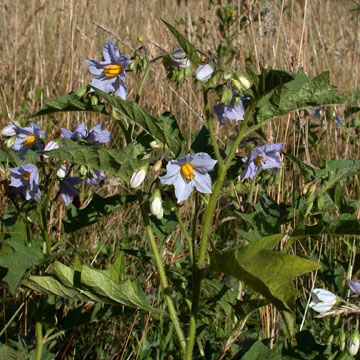

Solanum carolinense - (image 1 of 5)
Taxonomy
Family: Solanaceae
Habitat
Frequent in pastures and on abandoned agricultural land, most often in sandy soils.
Associates
Distribution
Native to the southeastern U.S. as far north as VA and KY. Naturalized north to VT, Ontario, MI, MN and most states to the west.
Morphology
Spiny, rhizomatous perennial to 1 m; stems erect, branching. Leaves to 12 cm long and half as wide, ovate, with 2-5 large teeth or shallow lobes on each side, more or less stellate hairy on both sides, the yellow centers of stellate hairs of lower leaf surfaces sessile, not elevated off the leaf surface. Inflorescence with several flowers, racemiform at maturity; corolla lavender or white, 2 cm wide; anthers equal, tapering to the tip; calyx to 7 mm long, stellate, sometimes with 1 or 2 short spines; fruit a yellow-orange, poisonous berry to 2 cm in diameter.
Notes
Flowers May to September
Wetland indicator: Facultative Upland -
The entire plant is deadly poisonous, including the fruit. Considered a noxious weed since grazing animals are often poisoned by eating plants growing in pastures. At least one death has been attributed to consumption of the berries.
References
Foster, S. and R.A. Caras. 1994. A Field Guide to Venomous Animals and Poisonous Plants: North America North of Mexico.
Houghton Mifflin Company. New York, NY. 244 pp.
Gleason, Henry A. and A. Cronquist. 1991. Manual of Vascular Plants of
Northeastern United States
and Adjacent Canada. Second Ed.
The New York Botanical Garden. Bronx, NY
Swink, F. and G. Wilhelm. 1994. Plants of the Chicago Region.
Indiana Academy of Science. The Morton Arboretum. Lisle, Illinois.
|
Michael Hough © 2010 |